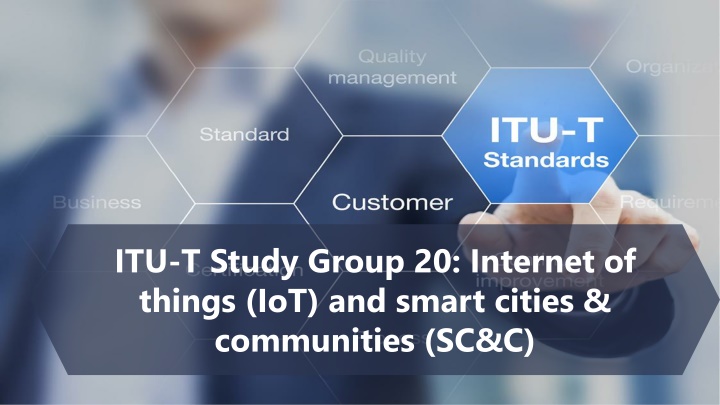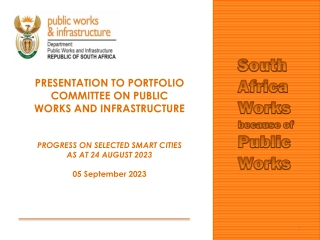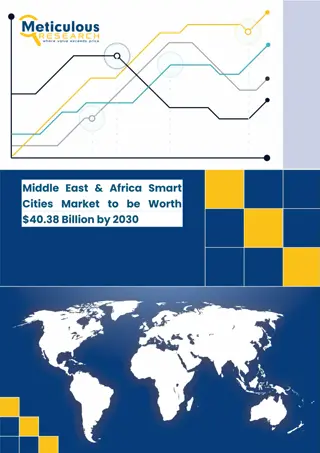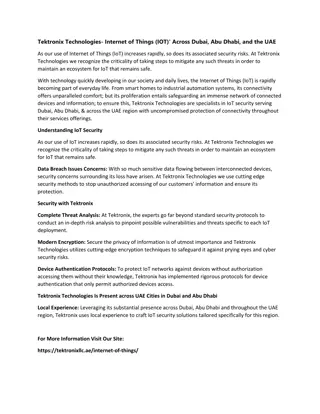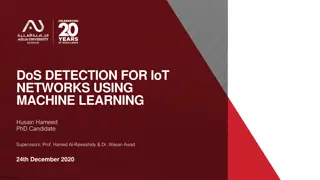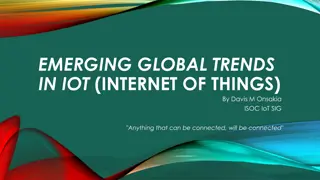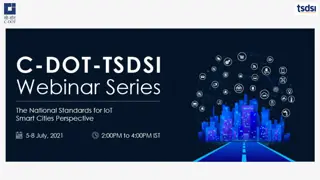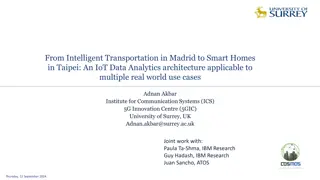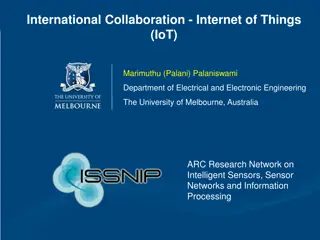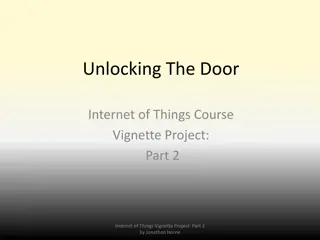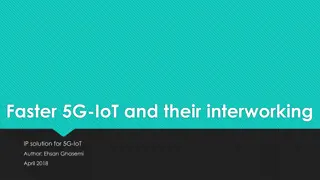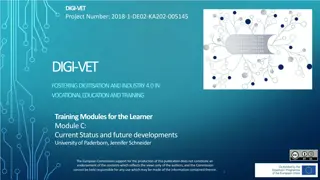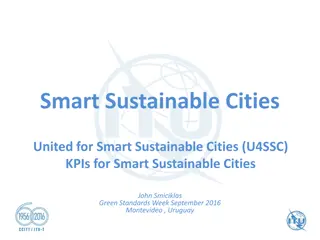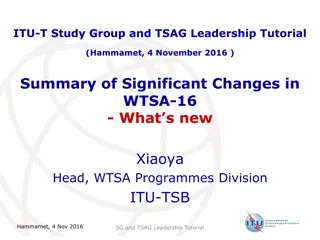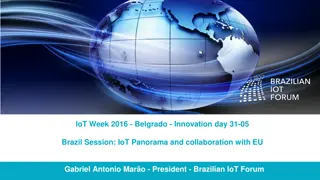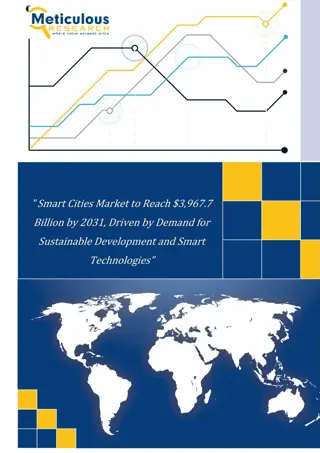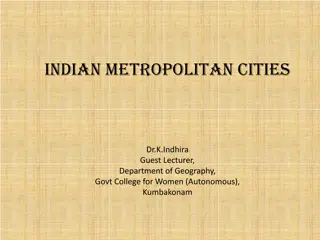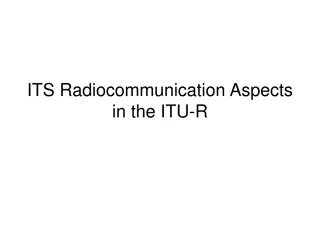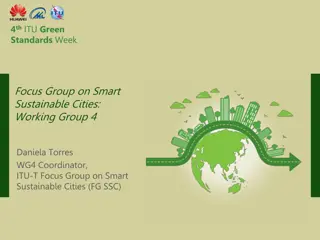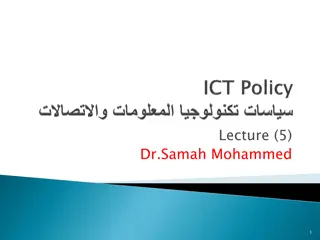ITU-T Study Group 20: Internet of things (IoT) and smart cities & communities (SC&C)
International Telecommunication Union (ITU) is the United Nations specialized agency for information and communication technologies (ICTs). With 193 member states, 550 sector members, and a focus on IoT, smart cities, and global collaboration, ITU plays a crucial role in promoting innovation, advancing technology, and connecting the world through telecommunications services. Joining ITU-T Study Group 20 offers opportunities to share knowledge, collaborate with diverse stakeholders, and drive market competitiveness in the ICT sector.
Download Presentation

Please find below an Image/Link to download the presentation.
The content on the website is provided AS IS for your information and personal use only. It may not be sold, licensed, or shared on other websites without obtaining consent from the author.If you encounter any issues during the download, it is possible that the publisher has removed the file from their server.
You are allowed to download the files provided on this website for personal or commercial use, subject to the condition that they are used lawfully. All files are the property of their respective owners.
The content on the website is provided AS IS for your information and personal use only. It may not be sold, licensed, or shared on other websites without obtaining consent from the author.
E N D
Presentation Transcript
ITU-T Study Group 20: Internet of things (IoT) and smart cities & communities (SC&C)
International Telecommunication Union (ITU) WHO WE ARE WHAT OUR ROLE IS ITU is the United Nations specialized agency for information and communication technologies (ICTs) To facilitate peaceful relations, international cooperation between peoples, and economic and social development by means of efficient telecommunications services. PROMOTING GLOBAL COLLABORATION FOR A CONNECTED WORLD
International Telecommunication Union OUR MEMBERS 193 MEMBER STATES 550 SECTORMEMBERS 140 ACADEMIA MEMBERS 170 ASSOCIATES STANDARDIZATION 3 SECTORS DEVELOPMENT Each sector has separate mandate, but all work cohesively towards connecting the world RADIOCOMMUNICATION
Why you should join ITU-T SG20? SMEs pilot project Share your knowledge with 193 Member States, 700 Private Sectors and over 140 Academia United Nations specialized Agency for ICTs Embody diverse perspectives Serve as building blocks for innovation Address broad market needs Leverage expert knowledge Encourage market competition Open new markets and applications Streamline development and implementation Drive global innovation and advancement Drive interoperability and scalability Reduce cost 4
ITU-T Study Group 20: Internet of things (IoT) and smart cities and communities (SC&C) Lead study group on Internet of things (IoT) and its applications Responsible for studies relating to IoT and its applications, and smart cities and communities (SC&C). Smart Cities and Communities (SC&C), including its e-services and smart services It includes studies relating to Big data aspects of IoT and SC&C, e-services and smart services for SC&C 4 Regional Groups SG20 RG-AFR SG20 RG-EECAT IoT identification SG20 RG-LATAM SG20 RG-ARB 5
ITU-T SG20 Structure WP1/20 Q1/20 Questions End to end connectivity, networks, interoperability, infrastructures and Big Data aspects related to IoT and SC&C Requirements, capabilities, and use cases across verticals Architectures, management, protocols and Quality of Service e/Smart services, applications and supporting platforms Q2/20 Q3/20 Q4/20 WP2/20 Q5/20 Research and emerging technologies, terminology and definitions Security, privacy, trust and identification Evaluation and assessment of Smart Sustainable Cities and Communities Q6/20 Q7/20
ITU-T SG20 Regional Groups SG20 RG-EECAT - ITU-T SG20 Regional Group for Eastern Europe, Central Asia and Transcaucasia SG20 RG-LATAM - ITU-T SG20 Regional Group for the Latin American Region SG20 RG-ARB - ITU-T SG20 Regional Group for the Arab Region SG20 RG-AFR - ITU-T SG20 Regional Group for the Africa Region
Most recent approved ITU-T Recommendations (1) Recommendation ITU-T Y.4101/Y.2067 "Common requirements and capabilities of a gateway for Internet of Things applications ". Recommendation ITU-T Y.4101/Y.2067 provides the common requirements and capabilities of a gateway for Internet of things (IoT) applications. The provided common requirements and capabilities are intended to be generally applicable in gateway application scenarios. Recommendation ITU-T Y.4116 "Requirements of transportation safety service including use cases and service scenarios " This Recommendation describes requirements for providing transportation safety services. The use cases and related service scenarios which are used to extract requirements for various IoT services and applications are also described in this Recommendation. Recommendation ITU-T Y.4117 Requirements and capabilities of Internet of Things for support of wearable devices and related services . The purpose of this Recommendation is to describe characteristics, specific requirements and capabilities of the IoT for support of wearable devices and related services. Recommendation ITU-T Y.4455 Reference architecture for IoT network service capability exposure . This Recommendation introduces IoT network capability exposure (IoT NCE). The IoT NCE is a functional entity in network domain, and facilitates the Internet of things (IoT) applications and services to make full use of capabilities of their underlying networks. The IoT NCE can optimize user experience, improve network efficiency and expose network capability in order to optimize IoT applications and services. Recommendation ITU-T Y.4806 Security capabilities supporting safety of the Internet of Things . This Recommendation provides a classification of the security issues for the Internet of Things and examines how the security threats may affect safety, in order to determine which security capabilities specified in Recommendation ITU-T Y.4401/Y.2068 support safe execution of the Internet of Things.
Most recent approved ITU-T Recommendations (2) Recommendation ITU-T Y.4114 "Specific requirements and capabilities of the IoT for Big Data". This Recommendation complements the developments on common requirements of the IoT [ITU-T Y.2066] and functional framework of the IoT [ITU-T Y.2068] in terms of the specific requirements and capabilities that the IoT is expected to support in order to address the challenges related to Big Data. Recommendation ITU-T Y.4115 "Reference architecture for IoT device capability exposure" This Recommendation specifies reference architecture of IoT device capability exposure (IoT DCE) which supports IoT applications in DCE devices (e.g., smart phones, tablets and home gateways) to access device capabilities exposed by IoT devices connected to the DCE device. Recommendation ITU-T Y.4805 Identifier service requirements for the interoperability of Smart City applications . This Recommendation explores the set of requirements for identifier services used in Smart City. An identifier service for Smart City must be scalable and secure, and not only promote interoperability among different Smart City applications, but also compatible with any existing practices in the application domain.
Focus Group on Data Processing and Management to support IoT and Smart Cities & Communities (FG-DPM) Key priorities: 5 Working Groups To propose mechanisms , frameworks and guidelines for supporting the security, privacy and interoperability of datasets and data- management systems within the IoT and smart city domain. WG1 - Use Cases, Requirements and Applications/ Services WG2 - DPM Framework, Architectures and Core Components WG3 - Data sharing, Interoperability and Blockchain WG4 - Security, Privacy and Trust including Governance WG5 - Data Economy, commercialization and monetization 10
JCA IoT and SC&C To coordinate the activity on IoT & SCC across ITU-T Study Groups and to coordinate with ITU-R and ITU-D. To provide a visible contact point IoT and SC&C activities in ITU-T, to seek co-operation from external bodies working in the field of IoT & SCC and enable effective two-way communication with these bodies. Maintenance of a list of cross-SDO IoT & SCC standardization items and associated roadmap. Co-Conveners: Hyoung Jun Kim (ETRI, Korea) Fabio Bigi (Italy) D.2r16 - IoT and SC&C standards roadmap (free download) Send us your inputs! Secretariat: Contact: tsbjcaiot@itu.int
Thank you ITU-T, IoT and smart cities & communities http://itu.int/go/tsg20 tsbsg20@itu.int 12
Question Q2/20 Q2/20 Q2/20 Q3/20 Q3/20 Q3/20 Q3/20 Q3/20 Q3/20 Q3/20 Q3/20 Q3/20 Q3/20 Q3/20 Q3/20 Q3/20 Q3/20 Q3/20 Q3/20 Q3/20 Q3/20 Q3/20 Q3/20 Q3/20 Q3/20 Q3/20 Q3/20 Q3/20 Q4/20 Q5/20 Q6/20 Q6/20 Q6/20 Q7/20 Q7/20 Q7/20 Working title ITU-T Y.SCC-Reqts Y.UCS-Reqts Y.IoT-UAS-Reqts Y.oneM2M.IWK.LwM2M Y.oneM2M.PB.WebSocket Y.oneM2M.MAF.MEF Y.oneM2M.DG.DM Y.oneM2M.DG.AppDev Y.oneM2M.DG.CoAP Y.oneM2M.InteropTest Y.oneM2M.CT Y.oneM2M.PB.MQTT Y.oneM2M.PB.HTTP Y.oneM2M.SLCP Y.oneM2M.SEC.SOL Y.oneM2M.DG.SEM Y.oneM2M.ARC Y.oneM2M.DM.OMA Y.oneM2M.PB.CoAP Y.oneM2M.TF Y.oneM2M.FDC Y.oneM2M.HAIM Y.oneM2M.Ind.DE Y.oneM2M.BO Y.oneM2M.DM.BBF Y.UIIS-IoT Y.oneM2M.UCC Y.oneM2M.REQ Y.disaster_notification Y.MEDT Y.API4IOT Y.LPWA Y.FW-IC-MDSC Y.SSC-IA Y.SSC-MM Y.AFDTS Title Common requirements and capabilities of smart cities and communities from IoT and ICT perspectives Requirements and capabilities of user-centric work space service Use cases, requirements and capabilities of unmanned aircraft systems for Internet of Things oneM2M- LwM2M Interworking oneM2M- WebSocket Protocol Binding oneM2M- MAF and MEF Interface Specification oneM2M- Developer guide of device management oneM2M- Application developer guide: Light control example using HTTP binding oneM2M- Developer Guide of CoAP binding and long polling for temperature monitoring oneM2M- Interoperability Testing oneM2M- Common Terminology oneM2M- MQTT Protocol Binding oneM2M- HTTP Protocol Binding oneM2M- Service Layer Core Protocol Specification oneM2M- Security Solutions oneM2M- Developer Guide of Implementing semantics oneM2M-Functional Architecture oneM2M- Management Enablement (OMA) oneM2M- CoAP Protocol Binding oneM2M- Testing framework oneM2M- Field Device Configuration oneM2M- Home Appliances Information Model and Mapping oneM2M- Industrial Domain Enablement oneM2M Base Ontology oneM2M- Management enablement (BBF)" (New) Unified Identity/Identifier/Locator Split (UIIS) Services and Architecture in IoT Environment oneM2M- Use Case Collection oneM2M- Requirements Framework of the disaster notification of the population in Smart Cities and Communities Methodology for Building Sustainable Capabilities during Enterprises Digital Transformation API for IoT Open Data in Smart Cities Security, interoperability and identification aspects for Low Power Wide Area (LPWA) systems Framework of identification and connectivity of Moving Devices in Smart City Smart Sustainable City Impact Assessment Smart Sustainable City Maturity Model Assessment Framework for Digital Transformation of Sectors in Smart Cities New work items
ITU-T SG20 main results October 2015 August 2017 9 New Recommendations approved 9 New Supplements agreed ITU-T Y.4113 Requirements of the network for the Internet of Things ITU-T Y.4114 Specific requirements and capabilities of the IoT for Big Data ITU-T Y.4115 Reference architecture for IoT device capability exposure" ITU-T Y.4451 Framework of constrained device networking in the IoT environments ITU-T Y.4452 Functional framework of Web of Objects ITU-T Y.4453 Adaptive software framework for IoT devices ITU-T Y.4553 Requirements of smartphone as sink node for IoT applications and services ITU-T Y.4702 Common requirements and capabilities ITU-T Y.4805 Identifier service requirements for the interoperability of Smart City applications . ITU-T Y.Supp.42 to ITU-T Y.4100 series Use cases of User-Centric work Space (UCS) Service ITU-T Y.Supp.34 to ITU-T Y.4000 series "Smart Sustainable Cities - Setting the stage for stakeholders' engagement" ITU-T Y.Supp.33 to ITU-T Y.4000 series "Smart Sustainable Cities - Master plan" ITU-T Y.Supp.32 to ITU-T Y.4000 series "Smart sustainable cities - a guide for city leaders ITU-T Y.Supp.31 to ITU-T Y.4550 series "Smart Sustainable Cities - Intelligent sustainable buildings ITU-T Y.Supp.28 to ITU-T Y.4550 series Integrated management for smart sustainable cities ; ITU-T Y.Supp.29 to ITU-T Y.4250 series Multi-service infrastructure for smart sustainable cities in new-development areas ; ITU-T Y.Supp.30 to ITU-T Y.4250 series Overview of smart sustainable cities infrastructure ; ITU-T Y.Supp.27 to ITU-T Y.4400 series Setting the framework for an ICT architecture of a smart sustainable city . 15
Publication on IoT and Smart Sustainable Cities Flipbook on Shaping smarter and more sustainable cities: Striving for Sustainable Development Goals Flipbook on Unleashing the potential of the Internet of Things This compendium of Technical Reports and Specifications details policy and technical considerations relevant to the development of SSC, providing policymakers and engineers with valuable reference material to guide their pursuit of happier, safer life in our cities. This flipbook presents a compendium of the first set of ITU international standards for IoT, providing a resource of great value to standards experts interested in contributing to the work of ITU-T Study Group 20. Available on ITU website for free!
